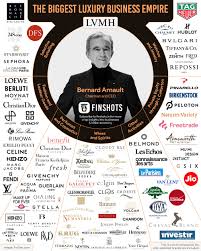Understanding LVMH: Leader in Luxury Goods Industry

Introduction
As a powerhouse in the luxury goods sector, LVMH Moët Hennessy Louis Vuitton, commonly known as LVMH, exemplifies the pinnacle of opulence and brand prestige. With its extensive portfolio of iconic brands, LVMH not only shapes fashion and consumer trends but also significantly influences the global economy. With the recent economic shifts and changing consumer behaviour, LVMH’s strategies and performances have become crucial to observe for industry stakeholders and investors alike.
LVMH: A Market Leader
Founded in 1987 through a merger of Moët Hennessy and Louis Vuitton, LVMH has steadily expanded its business operations, now encompassing over 75 renowned brands across many sectors, including fashion, cosmetics, watches, and wines. In its latest quarterly reports for 2023, LVMH generated €21 billion in revenue, representing a 15% growth compared to the same period last year, showcasing its resilience and adaptability in a post-pandemic world. Notably, its Fashion and Leather Goods division, which includes brands like Dior and Celine, was the standout performer, credited for more than 40% of the overall revenue.
Recent Developments
The recent acquisition of high-profile brands has bolstered LVMH’s dominance in the market. The inclusion of companies like Tiffany & Co. and the expansion of its cosmetics line through the purchase of a stakes in brands like Pat McGrath Labs exemplifies LVMH’s aggressive growth strategy. Furthermore, LVMH has actively embraced sustainability initiatives, recognising the changing consumer demand for responsible luxury. The introduction of eco-friendly production methods and sustainable packaging is aimed at attracting the environmentally conscious customer of today.
Impact of Economic Trends
The broader economic landscape impacts LVMH’s market strategies. Despite rising inflation rates and potential economic downturns, luxury brands have shown remarkable resilience. Recent reports indicate that affluent consumers continue to seek luxury experiences, further driving LVMH’s growth. Analysts predict that luxury consumption will maintain its upward trajectory, with LVMH expected to lead this growth due to its diversified portfolio and market readiness.
Conclusion
In conclusion, LVMH is not just a leader in luxury goods but also an influential force that shapes market trends and consumer behaviour. Its innovative business strategies, combined with a robust response to environmental concerns and market demands, position LVMH for continued success. As the luxury sector evolves, LVMH’s adeptness in navigating economic challenges will be critical for maintaining its market leadership. For investors and industry observers, LVMH’s forthcoming performance is a key indicator of the luxury goods market’s health and resilience.
